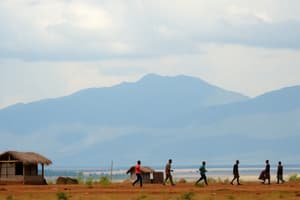Podcast
Questions and Answers
Где расположена арктическая тундра?
Где расположена арктическая тундра?
- На западе России, от границы с Беларусью до Финского залива
- На севере России, от Полярного Урала до Новосибирских островов (correct)
- На юге России, в районе Волжского региона и Крымского полуострова
- В центре России, от Каспийского и Черного морей
Что характеризует лесостепи?
Что характеризует лесостепи?
- Плотные леса и плодородные почвы (correct)
- Высокая продуктивность из-за влияния Каспийского и Черного морей
- Экстремально низкие температуры и короткие сезоны роста
- Расположение в южной части России
Какие животные обитают в арктической тундре?
Какие животные обитают в арктической тундре?
- Леопарды, жирафы, слоны
- Кенгуру, коалы, эму
- Фазаны, кролики, белки
- Полярные медведи, арктические лисицы, мускусные быки (correct)
Что делает лесоземля неудобной для сельского хозяйства и лесозаготовок?
Что делает лесоземля неудобной для сельского хозяйства и лесозаготовок?
Что характеризует степи в России?
Что характеризует степи в России?
Flashcards are hidden until you start studying
Study Notes
Natural Zones of Russia
Russia is known for its vast, diverse landscape encompassing various climates and ecosystems. This diversity can be observed through four primary natural zones: taiga, steppes, tundra, and lesozемiya. Each zone has unique characteristics and plays a crucial role within the broader Russian ecological system.
Taiga (Coniferous Forest)
Taiga forests cover approximately 76% of Russia's total land area. These dense forests primarily consist of conifers such as pine, spruce, fir, larch, and cedar, which grow in cold to subarctic conditions due to their ability to withstand low temperatures. Despite the harsh climate, these evergreen trees are able to sustain life through photosynthesis, providing food and shelter for animals like bears, moose, and caribou.
The Siberian taiga, located between latitudes 48°N and 68°N, is home to many species of wildlife including bison, owls, wolves, and numerous birds. The scientific name for this region is also "Siberia," stretching from the Ural Mountains to the Pacific Ocean.
Steps (Grasslands)
Steppes account for roughly 9% of the Earth's terrestrial surface and occupy some 3% of Russia's territory. They are often characterized by grasses up to 1 meter tall, forming continuous turf. Steppes have been traditionally used for agriculture, livestock grazing, and forestry.
In Russia, the steppe ecosystem is found in the southern part of the country, particularly in the weed-land regions of the North Caucasus and Crimea. This ecosystem is highly productive due to the influence of the Caspian and Black Seas, which bring heat and humidity to the region.
Tundra
Tundra is the coldest and most extreme of Russia's natural zones, covering around 3% of the country's territory. This sparsely vegetated biome, which includes the Arctic tundra and alpine tundra, experiences extremely low temperatures and short growing seasons.
The Arctic tundra is located in the northernmost parts of Russia, extending from the Polar Ural Mountains to the New Siberian Islands. It is home to a variety of cold-adapted animals such as polar bears, Arctic foxes, and musk oxen.
Lesozемiya (Least-Favored Forest Land)
Lesozемiya is the least productive of Russia's natural zones, covering over 15% of the country's territory. This area is characterized by low-density forests and poor soil, making it unsuitable for agriculture and forestry.
This region is primarily found in the southern parts of Russia, including the Volga region, the Crimean Peninsula, and the Black Sea coast. Despite its low productivity, lesozемiya is still important for maintaining biodiversity and preventing soil erosion.
In conclusion, Russia's natural zones - taiga, steps, tundra, and lesozемiya - each present distinct landscapes and habitats that contribute significantly to the country's overall ecology. Understanding these zones allows us to appreciate the immense biodiversity found across Russia and highlights the importance of preserving these unique environments for future generations.
Studying That Suits You
Use AI to generate personalized quizzes and flashcards to suit your learning preferences.




